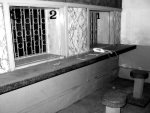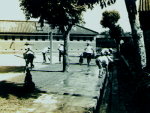Old Chiayi Prison under Japanese rule
(A sidewalk of the Jen cell block.)
(picture source:photo by this team.)
After losing the Sino-Japanese War, China ceded Taiwan to Japan in accordance to the Treaty of Shimonoseki. In the early days of Japanese colonialism in Taiwan, there were not yet any prisons. In Meiji 28, the Chiayi Prison Bureau was established; in Meiji 29, there were 13 prisons in Taiwan. The various prisons were alternately abandoned, separated, and reconstituted; after adjustments, during this period the Japanese did not yet purchase new prison facilities, so various prisons still used existing halls or temples from the Ch'ing Dynasty as prisons. Since at the time, the prison administrative authorities do not have doctors responsible for healthcare and disease prevention, many convicts died of diseases or escaped.

(The interview room in the old prison.)
(picture source:Provide by Mr. Sianyi Chen.)
Early on, after the prison bureaus began to accommodate prison regulations, Taipei County had Taipei, Hsinchu, and Ilan prison bureaus, Taichung County had Taichung, Miaoli, Lukang, Pulishe, and Yunlin prison bureaus, Tainan County had the Tainan, Chiayi, Hengchun, and Fengshan prison bureaus, and Penghu Island had its own prison bureau as well. In Meiji 39, the Meishan Earthquake occurred and destroyed much of Chiayi, and the Chiayi branch prison of Tainan prison was seriously damaged. In Taisho 8, the Chiayi BranchPrison (old Chiayi Prison) began to be constructed and was completed in Taisho 11.

(Prisoners were plowing)
(picture source:Provide by Mr. Sianyi Chen.)
The branch office was renamed the Chiayi Branch of the Tainan Executive Office. These six locations were under the jurisdiction of the prison facilities first constructed by the Japanese in Taiwan; architectural design of the old Chiayi Prison is strongly connected to the development of contemporary Western architecture. The prison rooms were arranged in a "fanning out" fashion, and adopted the eclecticism of mixed living in separate rooms; there are appropriate considerations in terms of discipline, healthcare, and operations.
Sources:
-
Researched and organized by this team
-
Planning and Research Report on Renovation and Reuse of the Old Chiayi Prison as A Historical Monument of Chiayi City
-
Nanhua University Master's thesis: Construction of Three Dimensions in Arenas of Power Study of Chiayi City, Old Chiayi Prison, and the Body
